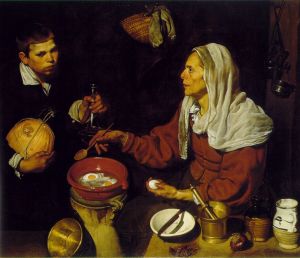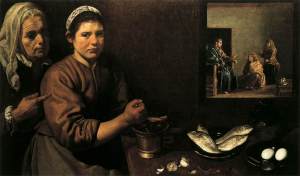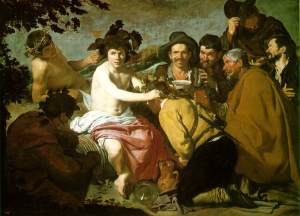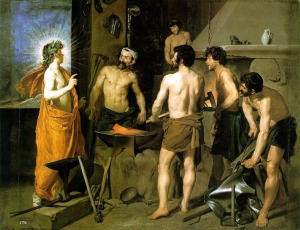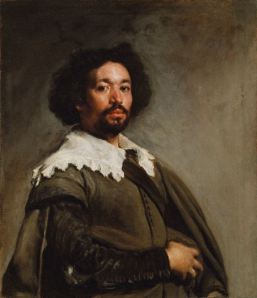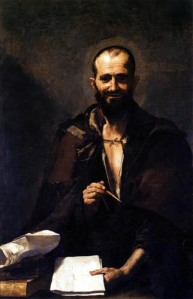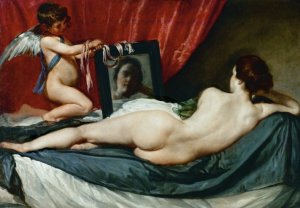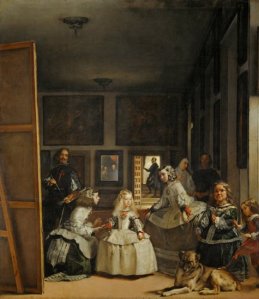Week 13: Diego Velázquez (1599-1660)
Old Woman Frying Eggs
Diego Velazquez 1617-1619.
Oil on canvas.
National Gallery of Scotland.
Diego Velazquez’s first biographer Palomino described a young Velazquez as very interested in painting from life while under the apprenticeship of Francisco Pacheco (Enggass 182).
This bodegóne, or still life with figures, is one of Velazquez’s first paintings, executed when he was a teen. It exemplifies the young artist’s interest in contrasting textures and points of view to make this scene a truly convincing reality. The mixture of still-life and genre scenes was popular in Spain at this time.
Influence from the Caravaggists can be seen in the stark tenebrism. Each item is depicted individually, as seen in Cotan’s still-lifes, yet has a Caravaggist extreme naturalism. The composition is pressed against the foreground with a dark, shallow background.
This piece is remarkable because it appears to be a natural, real scene to the naked eye. However, on closer examination, some items, such as the bowl of eggs and other items on the table, all appear to have their own perspective. No one thing is seen at the same point of view. We are looking down on the pot of eggs, yet the woman is in perfect profile.
Enggass, Robert and Jonathan Brown. Italian and Spanish Art 1600-1750; Sources and Documents. Palomino’s Life of Velazquez. pp. 180-196. Evanston: Northwestern University Press, 1970.
Christ in the House of Martha and Mary
Velazquez 1618.
Oil on canvas.
National Gallery, London.
This painting is typical of Velazquez’s style to come. It features a scene in the foreground with another scene either in the background, reflected in a mirror (so, behind the viewer), or in the painting on the wall. This type of double-subject matter has been seen in earlier paintings which featured Biblical scenes subordinate to the landscape in which they take place, and in genre scenes such as Pieter Aertsen’s Meat Stall that features the Flight into Egypt framed in the background by the meat cart up front. Velazquez would continue to paint these ambiguous double-subject paintings, including the more famous Las Meninas in 1656.
The scene in the foreground shows Mary and Martha tending to their house. It derives from a story in the Gospel of Luke in which Christ came to visit Mary and Martha. This portion of the story is shown in the upper right corner in what is most convincingly a mirror. The two scenes have an opposite direction of lighting. Again, we see Velazquez’s interest in naturalism in the varying textures of the items on the table. This painting fits into three of the popular subjects in Spanish art during the Baroque: religious, still-life, and genre.
Feast of Bacchus
Velazquez 1628-1629.
Oil on canvas.
Museo del Prado, Madrid.
Although from Seville, Velazquez painted this scene in Madrid. It is a different take on the popular subject of Bacchus. Unlike Caravaggio’s Bacchus, Velazquez’s is surrounded by drinkers. They are all, in fact, peasants dressed in contemporary clothing. Bacchus stands out as a very Classical god and has a much lighter skin color, separating him from the peasants. Tomlinson argues that Bacchus seems almost too human (90). The individualized expressions and poses of each man in this painting is a reflection of Velazquez’s interest in extreme naturalism.
Velazquez presents his Bacchus and the drinkers full length against a a landscape. He uses almost monochrome brown to unify this painting. It shares a similar tone with the Caravaggist Ribera’s Drunken Silenus from around the same time. There is a hint of Velazquez’s signature still-life in the foreground at the drinkers’ feet. This painting is a deviation from the court portraiture Velazquez had been doing up until this point.
Tomlinson, Janis. From El Greco to Goya: Painting in Spain 1561-1828. New York: Harry N. Abrams, Inc., 1997.
Forge of Vulcan
Velazquez 1630.
Oil on canvas.
Museo del Prado, Madrid.
This painting marks a change in Velazquez’s style. He had taken a trip to Italy in 1629. While there, his primary biographer Palomino tells us that the Sevillian artist was exposed to the great works by Tintoretto, Titian, Veronese, Federico Zuccaro, Raphael, and Michelangelo to name a few (Enggass 186-187). This had a vast impact on his style from there on out.
This painting is composed very Classically in that it features full length figures across the foreground of the picture plane. A move away from Caravaggio’s extreme naturalism can be seen in Velazquez’s nearly idealized figures. The graceful stances of the half-nude men contrast Velazquez’s frumpy peasants in Bacchus. The artist uses gesture, expression, and affeti. This scene takes place neither in a landscape nor an ambiguous dark space, but a rather developed sense of place.
Enggass, Robert and Jonathan Brown. Italian and Spanish Art 1600-1750; Sources and Documents. Palomino’s Life of Velazquez. pp. 180-196. Evanston: Northwestern University Press, 1970.
Juan de Pareja
Velazquez 1650.
Oil on canvas.
For exhibit in the Pantheon, now in Metropolitan Museum of Art.
Velazquez was a renowned portrait painter, and this painting of his servant and pupil is no exception to the artist’s exquisite craftsmanship. His use of brushstrokes gives this portrait its life-like textures.
Velazquez painted this for a competition to have a piece of art in an exhibition in the Pantheon in 1650. It is the first work he executed while on his second trip to Rome. Juan is featured at three-quarter length, showing only one hand. His gaze is off the picture plane, yet unfocused, as if staring over the viewer’s shoulder. The background is non-existent, yet Juan inhabits the space nonetheless. Velazquez’s use of scumbling – layering light colors over dark – gives the ambiguous background a sense of place. Velazquez also uses daubs of paint in a technique called impasto to create the highlights on Juan’s features. An Italian influence is obvious in this portrait. Velazquez may have beenlooking at Ribera’s Democritus from 1630 (right).
Rokeby Venus
Velazquez 1651.
Oil on canvas.
Now in the National Gallery, London.
This painting is another example of Velazquez’s ability to paint two different points of views and light sources within one composition. One of many, this particular double feature uses a mirror to convey the second point of view. We call this piece a Venus because the putto has arrows tied behind his back – Cupid.
The entire piece shows Velazquez’s Italian inspiration, notable Titian’s. It is painterly in style. The reflection of the young woman’s face is especially painterly, perhaps Velazquez’s way of showing off his abilities to paint different surface textures. It is also apparent that Velazquez used a painting technique called borrón. This is a way of glossing paint over multiple layers to create a multi-tonal affect, derived from Venetian use of color.
Velazquez’s Venus is the first painting of a female nude in Spanish art (Sánchez). Although similar in pose to the many female nude paintings to follow, this one is different because Venus’s back is to the viewers. This makes it not only a modest nude, but also an ambiguous nude. The viewer does not know if he is actually looking at a nude woman, because the only thing to give the gender away is the feminine reflection.
Alfonso E. Pérez Sánchez. “Velázquez, Diego.” Grove Art Online. Oxford Art Online. 25 Apr. 2011 <http://www.oxfordartonline.com.libproxy.temple.edu/subscriber/article/grove/art/T088463>.
Las Meninas
Velazquez 1656.
Oil on canvas.
Museo del Prado, Madrid.
This is one of Velazquez’s most famous works. Its unclear and ambiguous subject matter is its greatest asset.
The tanglible subject of this piece is the Princess Margarita María with her maids of honor and servants in an actual room in her Alcázar. Velazquez is presented in a self-portrait, painting a large canvas. This painting is probably about the size of the canvas the artist has included in the composition, and so it can be viewed as him painting this particular painting. However, Velazquez’s famous use of pictures-within-pictures confuses the meaning of this painting. On a wall in the background, there is either a portrait of King Philip IV and Queen Mary Anne or a mirror. If indeed a mirror, this means the viewer is in place of the king and queen, or between the composition and the portrait sitters. It is also unclear what the man in the doorway represents.
Many aspects of this painting are executed in such a painterly manner that they appear abstract when viewed closely. This contrasts with the attention to detail Velazquez paid to the subject matter. Every figure is busy in an individual endeavor. Some tend to the Infanta, others are distracted, and Velazquez seems unaware of the ruckus, focused on his painting. The princess’s hair is rendered in such painstaking detail, one could almost see through her fine blonde locks to her elegant costume. The numerous pieces within this composition make it a complex piece, one of Velazquez’s most notable.
Alfonso E. Pérez Sánchez. “Velázquez, Diego.” Grove Art Online. Oxford Art Online. 25 Apr. 2011 <http://www.oxfordartonline.com.libproxy.temple.edu/subscriber/article/grove/art/T088463>.
